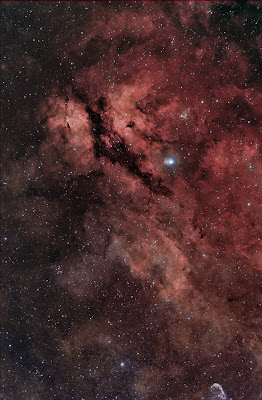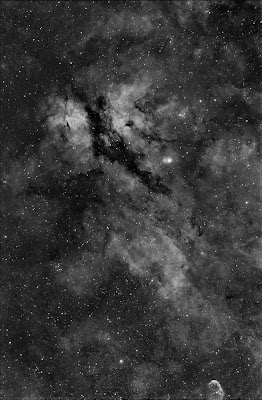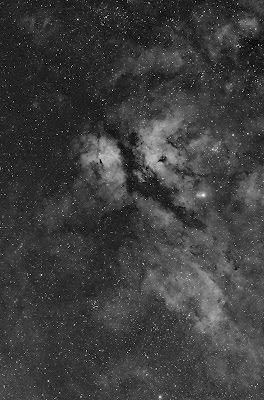COPYRIGHT, PLEASE NOTE
All the material on this website is copyrighted to J-P Metsavainio, if not otherwise stated. Any content on this website may not be reproduced without the author’s permission.
BUY A MUSEUM QUALITY POSTER
BUY A POSTER:https://astroanarchy.zenfolio.com/
Saturday, September 27, 2008
Butterfly Nebula, second try

O-III = Blue. Green channel is Synthesized from Red and Blue.
-
Conditions were not too good last night, hard wind and clouds.
Guiding was really difficult doe the wind but PHD-guiding software does its best.
There was jus enough gaps between clouds, that I managed shot data for H-alpha
and O-III not enough though.
Actually part of the frames are shot trough not so thin clouds, maybe
H-alpha acts as a cloud filter : )
S-II data had to be left to the next time after the clouds rolled in.
Part of the NGC6888 the "Crescent Nebula" can be seen in the bottom of the image.
-
Imaging data:
-
Camera,
QHY8
-
Filters,
Baader 7nm H-alpha and Baader 8,5nm O-III
-
Optics,
Tokina AT-X 300mm @ f2.8
-
Exposures,
5 X 1200s H-alpha
3 X 1200 O-III
+ flats and bias
-
Guiding,
LX200 GPS 12" + PHD-guiding and Lodestar

H-alpha channel
Wednesday, September 24, 2008
Butterfly Nebula from bad night

Sometimes there is days (nights), when everything goes wrong.
Last night was one of them.
First I had problems with my laptop and I had to reboot it several times.
It's a old well served Dell and booting it up takes for ever.
Then one of the cord to telescope was damaged and it took about an hour to
figure it out. After that I was ready so start my narrowband imaging session with
three filters.
First I selected H-alpha filter and got everything ready for imaging.
Guider was working fine and I started recording. I went out and stepped on the main power cord. Total blackout to the telescope. Huh... After an hour I got all on and running again (reinstalling couple of drivers etc...)
There was no more time for all three bands anymore, so H-alpha was now my goal.
After 7 x 1200s (20 min.) exposure they all looked good.
BUT BUT... when I examined them more closely and extracted red pixels from RAW-images
(thats how it works with one shot clor camera), I notised DEW, all but firs image was contaminated by dew.
There is a heater for my filter drawer to prevent dewing and cord from the power unit
was damaged! I soldered it back together but there was not enough night left for anything.
I shot flat frames just to be sure, and went to sleep for two hours before work.
Image here is a one twenty minutes exposure!
Camera, QHY8
Filter, Baader 7nm H-alpha
Optics, Tokina AT-X 300mm f2.8
Exposure, 1 X 1200s + flats and bias
Guiding, LX200 GPS 12" + PHD-guiding and Lodestar
Labels:
Tokina 300mm f2.8 images
Wednesday, September 17, 2008
NGC7000 as a Stereo Pair image
-
Images are stereo vision image pairs.
They tell something about "true" nature of this object.
This is not a accurate presentation of the real 3D dimensions,
but gives an idea about real nature of three dimensional object
floating in three dimensional space.
-
If you need istructions, please, look at the menu right side of the page.
Labels:
stereo images
Monday, September 15, 2008
My first ever narrowband color image!

This is a very modest example of three colur narrowband image. But I place it here, since it's my first one. At 11.09. I mainly shoot H-alpha, but before clouds rolled in I managed to capture 4 x 900s O-III and only single shot of S-II, 900s. I will shoot more O-III and S-III when ever weather allows me to do so. In this image the "Hubble paletete" is used where S-II = Red, H-alpha = Green and O-III = Blue
-
NOTE
This image is taken by using QHY8 cooled 6.1mb color camera.
Its not an ideal tool for narrowband imaging.
Each color channel is shooted trough separate filter, this means,
that only 1/4 pixels are used for H-alpha and S-II.
O-III goes mainly to the Green and Blue
pixels of the Bayer matrix array, so about 3/4 of the pixels are used in this case.
How ever, very high quality narrowband images has been taken by using color cameras.
Subscribe to:
Comments (Atom)










